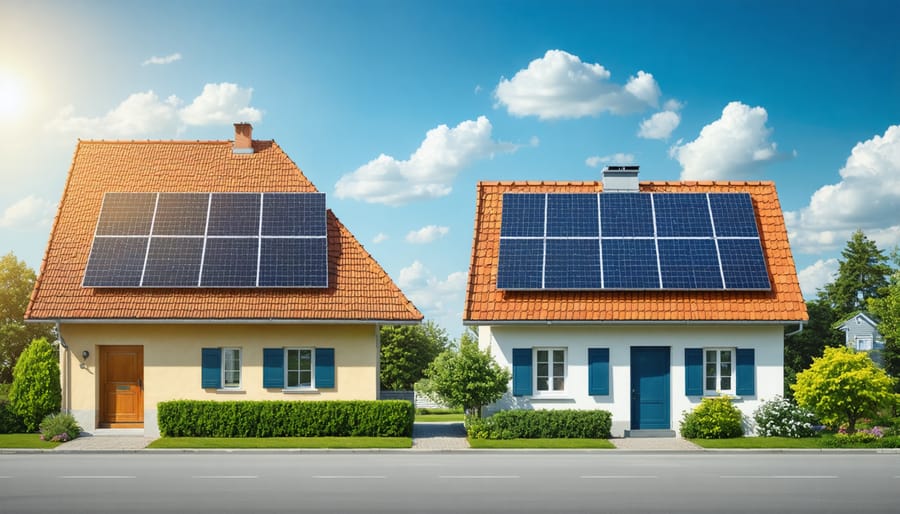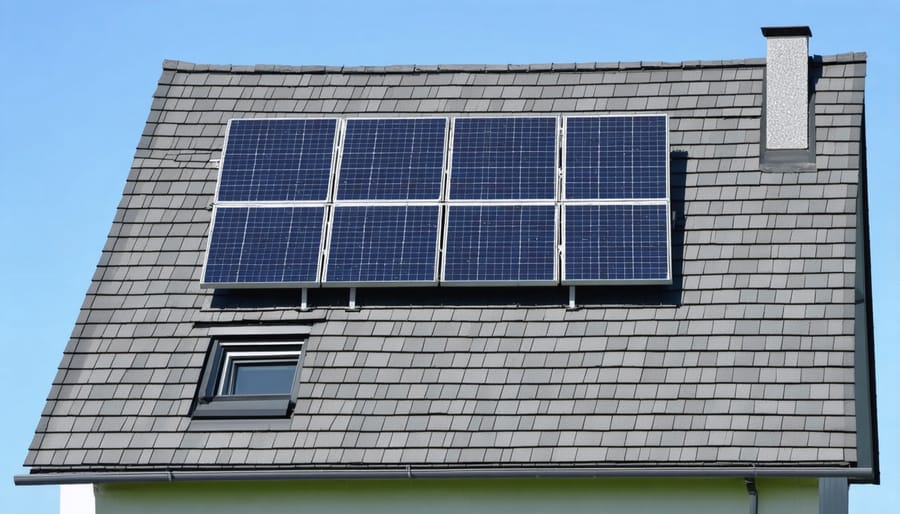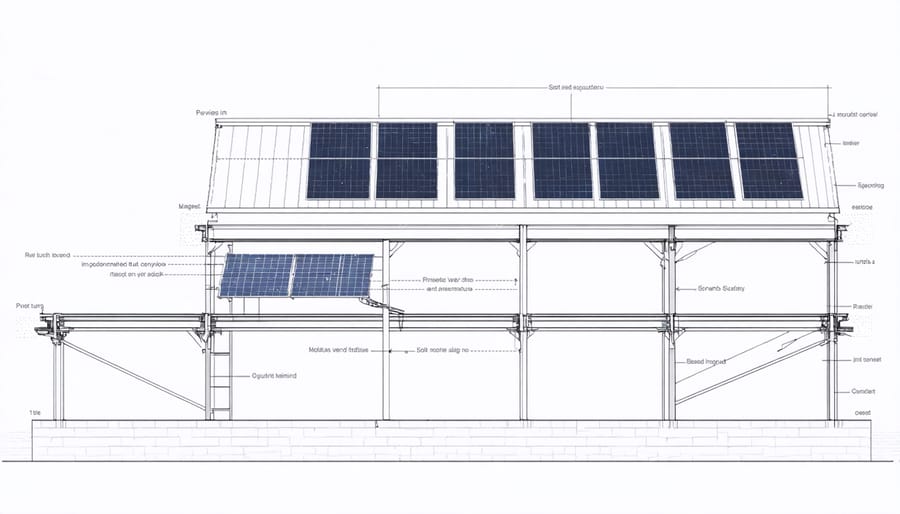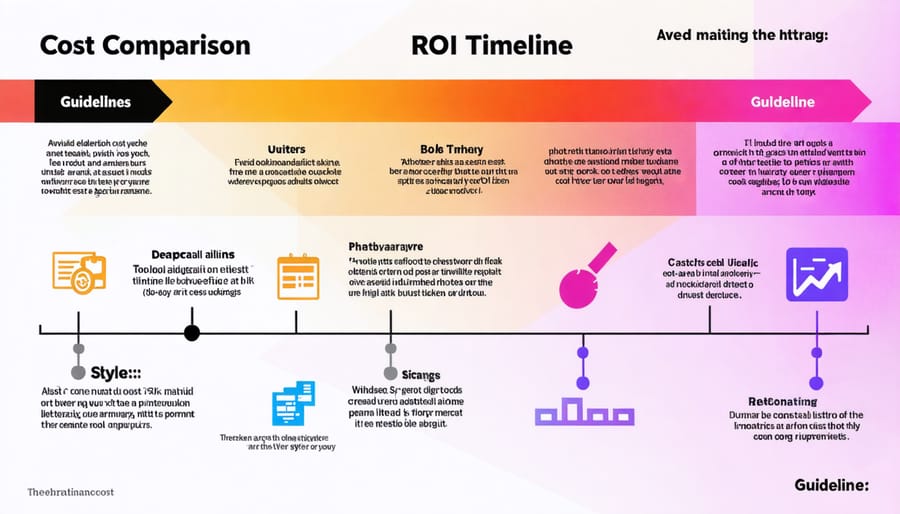Transform Your Roof Into a Power Plant: Solar Panel Replacement Made Clear

Transform your home into a sustainable power station by replacing traditional roof shingles with integrated solar panels – a strategic upgrade that delivers both environmental and financial benefits. As European homeowners increasingly embrace renewable energy solutions, understanding the key factors to consider becomes essential for successful implementation.
Modern solar roof systems offer exceptional durability while generating clean electricity, effectively serving dual purposes as both protective roofing and power generation units. Recent technological advances have made these systems more efficient and aesthetically pleasing, seamlessly blending with various architectural styles across European neighborhoods.
The transition from conventional shingles to solar panels represents more than an upgrade – it’s an investment in energy independence and property value. With EU initiatives supporting renewable energy adoption and many countries offering attractive incentives, the financial benefits extend beyond reduced electricity bills to include potential tax advantages and increased property marketability.
This comprehensive solution addresses both immediate roofing needs and long-term energy requirements, making it an increasingly popular choice for forward-thinking European homeowners committed to sustainable living. The integration process, when properly planned and executed, creates a robust, energy-generating barrier that protects your home while powering it for decades to come.

Why Replace Traditional Shingles with Solar Panels?
Energy Generation Benefits
Solar panels installed as roof replacements offer substantial energy generation benefits that can transform your property into a sustainable power station. A typical residential solar roof system in Europe can generate between 3,000 to 6,000 kilowatt-hours (kWh) annually, depending on location, roof orientation, and system size. This output can cover 60-90% of an average European household’s electricity needs.
The generation capacity is particularly impressive during summer months, when panels can produce up to 80% of their rated capacity during peak sunlight hours. Even in cloudy conditions, modern solar technology ensures consistent energy production, typically maintaining 25-35% efficiency. This reliable power generation translates to significant savings on electricity bills, with many homeowners reporting reductions of €500-€1,000 annually.
Beyond immediate power generation, these systems often produce surplus energy during peak hours, which can be fed back into the grid through net metering programs or stored in home battery systems for evening use. The energy independence gained through solar roof integration provides a hedge against rising electricity prices while contributing to Europe’s renewable energy targets.
Environmental Impact
Replacing traditional roof shingles with solar panels delivers significant environmental benefits that extend far beyond individual households. The transition substantially reduces carbon emissions, with a typical residential solar installation preventing approximately 1.5-2 tonnes of CO2 emissions annually. This impact is particularly notable in European regions, where solar adoption directly supports the EU’s ambitious climate goals.
The manufacturing process of solar panels has also become increasingly sustainable, with many European manufacturers implementing closed-loop production systems and recycling programs. Modern solar panels have a minimal environmental footprint during their 25-30 year lifespan, especially when compared to conventional roofing materials that require more frequent replacement.
Beyond carbon reduction, solar panel installations help decrease local air pollution and reduce water consumption associated with traditional power generation. The panels also contribute to biodiversity protection by minimizing the need for resource extraction and fossil fuel mining. As an added benefit, the growing solar industry has stimulated eco-friendly innovation in manufacturing and installation techniques, creating a positive ripple effect throughout the sustainable construction sector.
Technical Considerations for Solar Roof Integration
Structural Requirements
Before installing solar panels, your roof must meet specific structural requirements to ensure safety and optimal performance. A qualified structural engineer should assess your roof’s load-bearing capacity, as solar panels typically add 15-20 kg/m² to your roof’s weight. This evaluation becomes particularly crucial for older European buildings with traditional roofing structures.
The ideal roof orientation for solar panels in Europe is south-facing, with an inclination angle between 30-45 degrees. However, east or west-facing roofs can still achieve approximately 85% of optimal energy production. The roof surface should be free from shadows cast by nearby buildings, trees, or chimneys, as shading can significantly impact solar panel efficiency.
Your roof’s condition is paramount – it should be in good repair with no signs of water damage or structural weakness. Any necessary repairs or reinforcements must be completed before installation. The supporting structure beneath your shingles needs to be robust enough to accommodate both the mounting system and the ongoing maintenance requirements.
The installation process requires proper waterproofing measures, including specialized flashing and sealants suitable for your local climate. Most European installations utilize either rail-mounted systems or roof hooks, depending on your roof type and local building regulations. Your roof should have adequate ventilation to prevent heat buildup under the panels, which can affect both panel efficiency and roof longevity.
Consider future accessibility needs for maintenance and repairs when planning the panel layout. Leave sufficient space around roof edges and maintain clear paths between panel arrays for safe access during inspections and servicing.

Installation Process
The installation process of replacing roof shingles with solar panels typically takes 2-3 days and involves several carefully orchestrated steps. Initially, professional installers assess the roof’s condition and remove the existing shingles from the designated installation area. This step includes inspecting the underlying structure to ensure it can support the new solar panel mounting systems.
Next, installers apply a new waterproof underlayment to protect your roof from moisture infiltration. They then install specialised flashing around roof penetrations and along the edges to prevent water ingress. The mounting hardware is secured directly to the roof rafters, ensuring optimal stability and load distribution.
The electrical groundwork follows, with installers running conduit and wiring from your roof to the electrical panel. This infrastructure will carry the power generated by your solar panels to your home’s electrical system. The panels are then carefully lifted onto the roof and secured to the mounting framework, typically in a grid pattern that maximises exposure to sunlight.
Finally, the system undergoes thorough testing and commissioning. Certified electricians connect the panels to the inverter and your home’s electrical system, ensuring compliance with all European safety standards and regulations. The entire process is overseen by qualified professionals who coordinate with local authorities for necessary inspections and certifications.
Throughout the installation, contractors maintain strict safety protocols and use protective measures to safeguard your property. Upon completion, you’ll receive comprehensive documentation and guidance on system operation and maintenance requirements.
Cost Analysis and ROI
Initial Investment Comparison
When comparing initial investments, traditional roofing and solar panel installations present distinct cost considerations for European homeowners. A standard roof replacement with high-quality shingles typically costs between €8,000 and €15,000 for an average-sized home of 150 square meters. This includes materials, labour, and basic warranties.
In contrast, a solar panel installation integrated with roofing materials generally ranges from €20,000 to €35,000 for the same roof area. While this represents a significantly higher upfront investment, it’s essential to consider that solar panels serve dual purposes: protecting your home while generating electricity.
The cost difference becomes more nuanced when factoring in available incentives. Many European countries offer substantial subsidies, tax benefits, and green energy grants that can reduce the initial investment by 20-40%. For instance, Germany’s KfW programme provides low-interest loans and direct subsidies, while France offers tax credits through their transition énergétique scheme.
Additionally, modern solar installations often include smart monitoring systems, extended warranties of 20-25 years, and professional maintenance services. When calculating the total investment, consider that traditional roofing may require replacement after 15-20 years, while solar panels continue generating value throughout their operational lifetime through energy production and potential feed-in tariffs.

Long-term Financial Benefits
Installing solar panels as a roofing solution offers substantial long-term financial advantages that extend well beyond energy savings. Homeowners can typically expect to reduce their electricity bills by 50-90%, depending on their location and energy consumption patterns. When calculating your solar ROI, consider that most European countries offer significant financial incentives, including feed-in tariffs, tax rebates, and grants that can cover up to 30% of the initial installation costs.
The European Union’s commitment to renewable energy has led to enhanced support schemes across member states. For instance, Germany’s renewable energy act guarantees fixed payments for solar-generated electricity for 20 years, while France offers tax credits of up to €2,400 for residential installations. Additionally, property values typically increase by 3-4% with solar panel installation, making it a sound investment for future resale.
Modern solar panels have a lifespan of 25-30 years, during which they continue to generate free electricity. Maintenance costs are minimal, usually limited to occasional cleaning and basic system checks. When combined with smart energy management systems, solar installations can provide even greater savings through optimized consumption patterns and energy storage solutions. The financial benefits are particularly compelling when considering rising energy costs across Europe, with annual returns often exceeding 10% on the initial investment.
European Regulations and Support
Legal Requirements
Before installing solar panels in place of traditional roof shingles, homeowners must navigate several legal requirements and obtain necessary approvals. In most European countries, you’ll need to secure a building permit from your local authority, which typically involves submitting detailed plans of the installation, structural calculations, and electrical specifications.
Building regulations vary by country and municipality, but common requirements include structural assessment to ensure your roof can support the solar panel system’s weight, compliance with electrical safety standards, and adherence to local planning restrictions. In historic districts or conservation areas, additional permissions may be required, and certain aesthetic guidelines might apply.
Many European nations have specific regulations regarding grid connection and energy feed-in systems. You’ll need to notify your electricity provider and obtain necessary certifications for grid-connected systems. The installation must be performed by certified professionals who understand both roofing and solar energy systems.
Fire safety regulations are particularly important, as solar panels must be installed with appropriate access points for emergency services. Additionally, insurance providers should be consulted, as the modification may affect your home insurance coverage.
To ensure compliance, work with experienced solar installers who are familiar with local regulations and can handle the permitting process. They should provide documentation proving adherence to relevant European standards, including EN 61215 for photovoltaic modules and EN 50583 for building-integrated photovoltaics.
Available Incentives
The European Union and individual member states offer substantial financial support to encourage the transition to solar energy. Through the NextGenerationEU initiative, homeowners can access grants covering up to 40% of solar panel installation costs, including roof modifications. The European Regional Development Fund (ERDF) provides additional funding through local authorities, particularly for projects incorporating innovative building-integrated photovoltaic solutions.
At the national level, countries like Germany offer the KfW program, providing low-interest loans and direct subsidies for solar installations. France’s MaPrimeRénov scheme offers tax credits and direct payments based on household income and project scope. In Spain, the MOVES III program combines regional and national funding, offering up to €3,000 for residential solar installations.
Many European municipalities supplement these programs with local incentives, including expedited permits and reduced property taxes for buildings with solar installations. Energy companies often provide feed-in tariffs, allowing homeowners to sell excess electricity back to the grid at preferential rates.
For businesses, the European Investment Bank offers specialized green financing options, while the SME Climate Action Support program provides both technical assistance and funding support. It’s recommended to consult local energy agencies or certified solar installers to identify the most advantageous combination of incentives for your specific project.
Transitioning from traditional roof shingles to solar panels represents a significant step toward sustainable living and energy independence. Throughout this guide, we’ve explored the essential aspects of this transformative home improvement project, from technical requirements and financial considerations to regulatory compliance and environmental benefits.
The decision to replace your roof shingles with solar panels requires careful planning and consideration of various factors, including your home’s structural integrity, local climate conditions, and energy consumption patterns. By working with certified installers and following proper procedures, you can ensure a successful installation that meets European standards and maximizes your investment.
Remember that financial support mechanisms, including government incentives and EU-backed programmes, can significantly reduce your initial costs. Many European regions offer additional local subsidies, making the transition more affordable than ever before.
For homeowners ready to take the next step, we recommend:
– Conducting a professional roof assessment
– Obtaining multiple quotes from certified solar installers
– Reviewing local building regulations and permit requirements
– Calculating potential energy savings based on your consumption
– Exploring available financial incentives in your region
With proper planning and execution, replacing your roof shingles with solar panels can provide decades of clean energy while enhancing your property value. Contact local solar energy specialists to begin your journey toward a more sustainable and energy-efficient home.
Leave a Reply